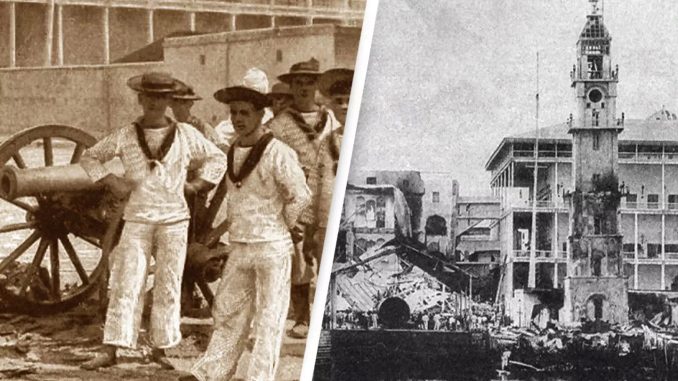
The Anglo-Zanzibar War, which took place in 1896, is widely known as the shortest war to ever take place.
But sadly, it had many casualties, despite barely lasting an hour.
It all started in August 1896, when the sultan of Zanzibar, Sultan Hamad, died suddenly. Britain, who had influence over the region at the time, had a preference over who would replace the sultan, but Prince Khālid ibn Barghash did not agree.
He took control himself instead – much to the disapproval of the British – which caused tensions between the two sides.
On August 25, the Brits arrived in Zanzibar with soldiers and gunboats, while Prince Khālid took refuge in the palace behind an army of 3,000 soldiers and supporters, as well as several artillery guns.
While directly asking Prince Khālid to surrender, the Brits were also sending troops to protect the British Consulate and control any rioting from the public.
Despite the growing tension – and the ultimatums that chief diplomat, Basil Cave issued to Khālid – the British troops could not proceed without the approval of the government at home.
Cave sent a telegram to the Foreign Office, asking: “Are we authorised in the event of all attempts at a peaceful solution proving useless, to fire on the Palace from the men-of-war?”
The next day, he received the following: “You are authorised to adopt whatever measures you may consider necessary, and will be supported in your action by Her Majesty’s Government. Do not, however, attempt to take any action which you are not certain of being able to accomplish successfully.”
Prince Khālid was issued one final ultimatum on 26 August, but did not surrender.
That afternoon, the harbours were cleared and British women and children taken to safety.
At 9am the following day, troops began infiltrating the palace, and at 9.02am, ships Racoon, Thrush and Sparrow opened fire on the palace, leading to around 500 casualties.
Many of those killed had died in the fire that engulfed the palace.
Khālid, however, ended up escaping, seeking shelter in the German Consulate before being smuggled into Tanzania. He remained on the run until he was captured in 1916, when British forces invaded East Africa.
Despite the conflict lasting just minutes, it took the lives of many of Khālid’s troops…….Seê _ Morê

Leave a Reply